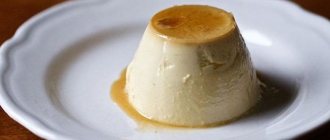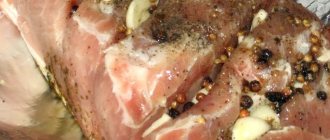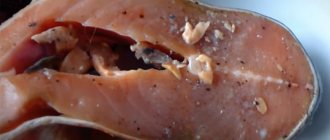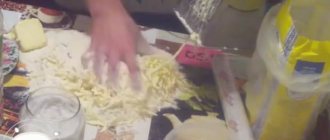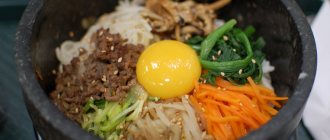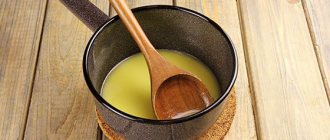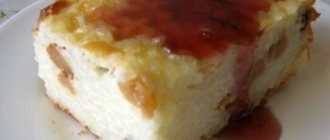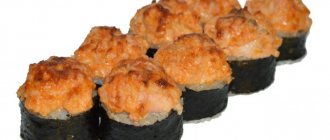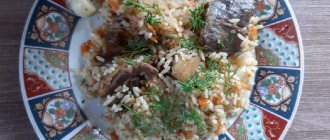Onigiri - simple in Japanese
Onigiri
– almost the most popular dish in the land of the rising sun. In Asia, they even create shops that specialize exclusively in making and selling onigiri. It consists of rice balls with various fillings.
This dish has a fairly long history of origin. There is an assumption that it appeared during military campaigns. Onigiri is actually very easy to eat on the go. You can eat them with your hands without fear of spilling them. Peasants working in the fields often took rice balls with them.
Making onigiri is not difficult. As the name suggests, this dish is based on rice. The top layer is formed from this cereal immediately after cooking, when it is still warm. Place the filling inside at your discretion. By the way, onigiri can be not only round. They can be formed into triangles, fried, wrapped in nori leaves, scrambled eggs and even slices of ham.
Rice balls are filled with seafood: tuna, salmon, eel. It can be katsuobushi and shrimp, kombu seaweed and pickled plum, pickled cucumber, soybeans and even fried meat. It is not necessary to hide the filling in the center of the ball. It can be mixed evenly with rice, placed under it or placed on top.
The right products are half the success
The main thing in making onigiri is to choose the right ingredients. Since the main component of this dish is rice, it is important not to miss in its choice. It should stick well, but not be too dry or too wet. It is best to use a round, unpolished one as the main component. The best option is special rice for Japanese dishes, which is sold in supermarkets.
After cooking, it can be slightly crushed to improve stickiness. Under no circumstances should you use a blender or meat grinder. This procedure can only be carried out with a knife. We also buy nori leaves at the supermarket there.
How to cook Rice Triangles
1. First, cook the rice according to the instructions on the package. Sprinkle the finished rice with vinegar and mix gently.
2. At the same time, take the nori leaves and cut them into strips. The size primarily depends on your molds and your imagination. You can use nori in rice triangles at home at your discretion.
3. You will also need a small plate of water in which to wet your hands. This will make it easier for you to work with rice.
4. And finally, special molds. However, you can also do without them.
5. If you are making filled triangles, add rice to fill about half of the pan. Make a well in the center, add spices and filling. Then fill the rest of the pan with rice.
6. Then carefully remove the finished triangle from the mold and wrap it with a nori leaf (you can do it on several sides, for example).
7. This is the resulting appetizing snack. Serve with soy sauce or teriyaki.
8. If you do not use the filling, then immediately mix the rice with spices and then place it in the mold. Don't forget to wet your hands with water every time.
Cooking onigiri at home
The technology for making onigiri is extremely simple. Although the Japanese believe that getting this dish truly right requires a lot of skill and more than a year of hard work.
For the base:
- a glass of rice;
- 9 strips of nori.
For filling:
- 9 pieces of lightly salted salmon, but any red fish will do.
Cooking process:
Wash the rice. To do this efficiently, you need to fill the bowl with water and drain it at least seven times. Boil the finished rice over high heat. After boiling, it is better to remove the lid and continue without it. Otherwise, the water will constantly foam and “run away” from the saucepan; by the way, it is better to take a thick-walled one. Cook in this way for a quarter of an hour, no need to stir.
As soon as the rice is ready, remove it from the stove and cover it with a clean napkin in two layers. Let it sit for half an hour. When the rice is cool enough to handle, you can begin the cooking process.
To ensure that all onigiri are the same size, immediately divide all the rice into 9 parts. Koloboks can be sculpted by hand or with a special device. We put the fish filling inside the ball and form it. We wind the prepared strips of nori along the outside.
An important point: when forming onigiri, you should not crush the rice too much. Overly carefully compressed cereal does not look very good and is not capable of delivering true pleasure.
Place the finished koloboks on a dish. It is better if it does not have any pattern. This rice dish goes great with cool vodka, plum wine or even beer.
Rice in Japanese cuisine
Traditional rice dishes of Japanese cuisine are:
Gohan - boiled rice. A bowl of rice is the centerpiece of a Japanese table. As they say, it is eaten three times a day. Rice serves as breakfast, rice is served as a main dish with miso soup and pickles, all other dishes are in addition to rice. In Western-style restaurants, rice is offered as an alternative to bread.
Also a popular Japanese breakfast is tamago kake gohan - this is boiled rice with the addition of a raw egg, the egg can be partially cooked. Soy sauce is also added to the rice. I read that Europeans do not like the taste of raw egg in rice.
Mochi cakes are made from glutinous rice. Mochi is a traditional New Year's dish, but it is eaten all year round in different variations. Mochi is still traditionally made by hand. Glutinous rice is boiled for a long time, and then ground with a special hammer in a mortar. Two people are involved in the cooking process - one crushes the mochi, and the second stirs the mass. Mochi is used to make Japanese sweets such as wagashi, ice cream is wrapped in mochi, and mochi is added to oshiruko, zoni, and chikara udon soups.
Onigiri rice balls are made from boiled rice and wrapped in nori (seaweed). Onigiri are lightly seasoned with salt with a filling inside. It can be umeboshi (pickled Japanese plum), okaka (dried mackerel shavings with kombu) or salmon and other fillings. Onigiri is an inexpensive popular snack, and the rice balls can be purchased at convenience stores, restaurants, and inexpensive cafes.
Fried rice - chahan , this dish was brought from China. You can add any ingredients to fried rice - peas, carrots, pork, negi (green onions). In Japan, rice is cooked without adding salt or spices. Fried rice in a series of dishes is usually served second to last, before dessert and when preparing chakhan, a type of rice is used that was not used in the first and second courses.
A fried rice dish can also include omuraishi , which is fried rice with the addition, as a rule. pieces of chicken meat (can be any other meat), herbs, wrapped in an omelette and sprinkled with ketchup.
Chazuke (ochazuke) is another type of boiled rice, which is filled with liquid - tea, fish broth, hot water, this dish is also decorated with various pickles, such as umeboshi, nori seaweed, wasabi, salted salmon, pickled seafood, fried onions salmon and other products. This dish is very popular and is offered in small restaurants as a recovery dish after drinking alcohol.
In Kyoto, chazuke plays an interesting role as a dish that sends away an overstaying guest. Chazuke is served last, and if the hosts offer to taste this dish, then the guests, after eating it, must immediately take their leave and leave the hospitable home, but often the guests refuse the offered dish and say goodbye to the hosts.
The Japanese dish kayu or o-kayu is a rice congee, which, unlike, for example, China, is cooked more densely. The ratio of water to rice is generally 7:1, in China it is 12:1. This dish is used mainly for medicinal or prophylactic purposes, as a light dietary dish. On January 7, the Japanese celebrate the festival of seven herbs, and as a festive and preventative dish after heavy New Year's feasts, rice porridge Nanakusa-gayu with seven healthy herbs added to the porridge is offered. rice water can also be supplemented with umeboshi.
Donburi literally means bowl; in Japan, this term refers to a number of rice dishes with meat, fish, and vegetables, which are cooked over low heat. It can be cooked rice with pork cutlet or fried beef, with chicken and egg, with fresh seafood, with grilled eel and other additions. As a rule, donburi is sold in specialized restaurants, but you can also find this dish in a regular restaurant.
Sushi is the most famous Japanese dish in our country and very popular among the Japanese. Sushi is made from white rice and seasoned with vinegar. The most common types are:
- nigiri - small rice balls topped with a strip of fish, eel, piece of squid, octopus, etc.
- gunkan - maki - is shaped rice wrapped in seaweed, caviar and sea urchin are used as filling
- nori-maki - rice stuffed with seafood, wrapped in seaweed (these are the usual rolls for us); rolls prepared with rice “inside out” are rare in Japan
- temaki - seaweed cones filled with rice, seafood, vegetables
Desserts made with rice include rice crackers and other sweets. Rice crackers come in baked and fried varieties, come in a variety of shapes and sizes, sweet and savory, and can be wrapped in seaweed and eaten with soy sauce.
To prepare sweets, sticky rice (mochi) and a sweet bean filling are used; popular sweets are daifuku and wagashi. Only natural products are used to prepare sweets. For Europeans, Japanese sweets may not seem sweet at all; they take some getting used to. But the fact that every representative of Japanese delicacy is a work of art is an indisputable fact. Most sweets are handmade and the principle that the Japanese eat twice, first with their eyes, and then start consuming is clear when you see sophistication in seemingly ordinary things.
Similar articles
- Japanese noodle dishes Noodle
are very popular in Japan.
The Japanese love both traditional national
noodle dishes - Traditional Japanese dishes
Japanese cuisine offers a wide variety
of dishes
.
Traditional cuisine
has regional differences... Read more - Japanese food
The Japanese also have
dishes
with the addition of spices, but as a rule they are consumed after
dishes
that carry the original taste. Read more
Onigiri and sushi
Contrary to popular belief, onigiri is not a type of sushi. Onigiri is made with plain rice, while sushi uses rice with vinegar, sugar and salt. Onigiri is a way to store and eat rice, while sushi originated as a way to store fish.
- Classic onigiri
- Fried onigiri.
- Set lunch of onigiri in the restaurant.
- Onigiri sold in a store.
Onigiri with salmon and cream cheese
Compound:
- sushi rice – 0.4 kg;
- water – 0.5 l;
- lightly salted salmon (fillet) – 0.2 kg;
- cream cheese – 150 g;
- sesame oil - to taste;
- nori – 12 pcs.
Cooking method:
- Rinse and place rice in boiling water. After cooking it over high heat for 5 minutes, reduce the flame intensity and continue cooking for 10 minutes.
- Leave to swell and cool, covered, for 20 minutes.
- Add oil, stir.
- Finely chop the lightly salted salmon fillet, add cream cheese, mix thoroughly.
- Place a large spoonful of rice on a piece of cling film and smooth it out slightly.
- Place a small spoonful of filling in the center.
- Lifting the ends of the film, form the rice into a ball. The filling should be in the center.
- Remove the film. Wrap a strip of seaweed around the rice ball. Place on a plate.
- Use the same method to form balls from the remaining rice.
When serving, rice balls can be sprinkled with sesame seeds. In Japan, onigiri stuffed with salmon fish are very popular. Europeans also like their taste.
Onigiri sushi (Rice balls)
Vegetables and legumes. Nuts, seeds, dried fruits. Nutritional supplements. Seasonings, spices. Fish and seafood.
Fruits and berries. Cooking method. Grill, barbecue.
Mobile version of the site Measures of weight of products. Onigiri sushi Rice balls 1 2 3 4 5. Share with friends:. Time: 2 hours.
Freeze, refrigerate. Bake, bake. Cook, simmer.
Type of food. Gluten-free recipes.
Cooking according to the recipe:
Vegan recipes. Vegetarian recipes. Children's menu. With your hands soaked in cold water, take a portion of rice, flatten it slightly, put the filling in the middle and roll the rice into a ball. Shape the finished balls into a triangle, sprinkle sesame seeds on top or wrap a ribbon of nori around them and serve with a thick omelette and spicy pickled vegetables. Core the apples and then cut them into slices. Pour boiling water over the lemon and cut into slices. Peel the minolas and cut into slices.
Cut the curtain into small pieces.
Description of preparation:
Wash leeks, Chinese cabbage and spinach and chop coarsely. Wash the seaweed leaf and put it in deep. Cut raw chicken meat into thin strips and sprinkle. Rinse the apples under running water, dry them with a towel or napkin, cut them in half and remove the core and seeds.
